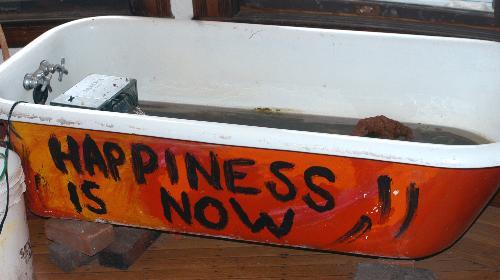
News
Pro-Palestine Encampment Represents First Major Test for Harvard President Alan Garber

News
Israeli PM Benjamin Netanyahu Condemns Antisemitism at U.S. Colleges Amid Encampment at Harvard

News
‘A Joke’: Nikole Hannah-Jones Says Harvard Should Spend More on Legacy of Slavery Initiative

News
Massachusetts ACLU Demands Harvard Reinstate PSC in Letter

News
LIVE UPDATES: Pro-Palestine Protesters Begin Encampment in Harvard Yard
Home Is Where the Art Is

The hardest part of finding art in the Dudley Co-op, Harvard’s quirkiest off-campus residence, is finding the co-op itself. After a ten minute walk up Oxford Street, there are no indications that Dudley is anything other than another house along quiet Sacramento Street—until the black-and-white hand-lettered sign above the door, touting the building as the “Center For High-Energy Metaphysics,” comes into view.
Inside, there isn’t a single spot unadorned by unique art and ornaments—and there are no rules and no limits for what goes up on its walls.
“People would just say, ‘I’m gonna do something here,’ and everyone else would be like, ‘sure,’” says co-op resident Catherine Y. Lowder ’03.
Even the downstairs bathroom, appropriately labeled with a poster advising “Dump the Fund,” contains a vivid painting of the house in shades of blue, green, red and purple. The painting is part of a mural that Nathaniel J. Tan ’03-’04 calls “kind of perpetually unfinished.”
Tan’s phrase is an accurate description for the whimsical and idiosyncratic artistic accoutrements of Dudley House. Residents of the co-op have gradually added decorations since Harvard first bought the building in 1958. The accumulation over the years ranges from Ouija boards and drums made from soup cans to Jimi Hendrix posters and an orange bathtub full of koi fish. And that’s just in the living room.
Some projects, like the Dr. Seuss mural in the kitchen, were probably a planned group effort. Others—like the cheddar-cheese labels in the shape of a flower that stick to the fridge or the lumpy root displayed on the mantle—seem to have been done purely on the spur of the moment.
The origin of most of this artwork is unknown to Dudley’s current residents, who can only recall the art that they added themselves: a few sugar-cereal boxes and newly painted walls. Rather than adding new work, they take pride in discovering interesting details in the art that already surrounds them already on the walls—such as a photograph of some former residents recreating Raphael’s “School of Athens” or the paper clock adjacent to an actual one, mounted upside-down.
In keeping with Dudley’s liberal reputation, a significant number of items concern political expression. Signs abusing two generations of Bushes abound.
And halfway up the back staircase is what Tan terms “the Marxist wall,” where “Workers of the world, unite” is printed in dozens of languages, the number of which increases as those familiar with more obscure idioms take up residence.
One of the bedrooms has a line of marching soldiers painted in red. The dining hall has several frayed posters which look like Russian propaganda. Tan claims they were damaged in the “legendary Co-op fire” of 1994.
Some of the art serves a more practical purpose. Hand-made stained glass clouds a door’s window into one of the bedrooms on the third floor, while a painting of angels and trees ensures privacy for another room. A sign above the dining hall helpfully recommends, “don’t spit in the soup—we’ve all got to eat.”
A common feature of much of the original artwork in the house is its reliance on the written word. Lines from poems by Blake and Owen are penciled on random walls, and a painting of a jester in a cardboard frame accompanies a piece entitled “Waiting for Signs.” Magnetic poetry covers the refrigerators to foster the unexpected burst of creativity, with recent compositions such as “summer girl shake / frantic light spray / puppy / crush” and “how from the incubate pole / a cold sun shines.”
In the entrance hall, a dozen paper bags are taped to the wall.
“Holy in a bag,” reads one of them. “Suck this in and you will be holy.”
The others display similar messages, substituting “holy” with everything from “whining” to “blue.” These were added just recently, and Tan recalls some posters by the same artist that had fallen down in recent years.
And Dudley-dwellers years from now may read the same messages.
The only way art ever leaves the co-op, Tan says, is if it somehow drops off the wall.
Want to keep up with breaking news? Subscribe to our email newsletter.
